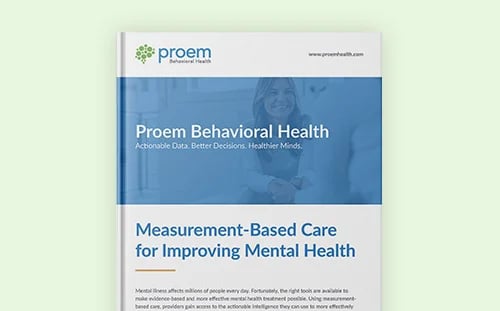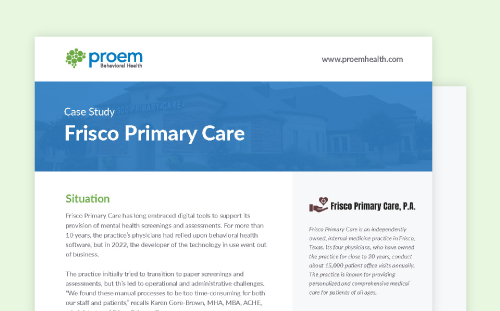
The term “behavioral health” encompasses a wide range of conditions related to mental health, including substance use disorders (SUD). However, behavioral health conditions frequently impact physical illnesses as well. Events such as life stressors and crises (e.g., job loss, serious illness of a loved one), stress-related physical symptoms (e.g., insomnia, elevated blood pressure) and generally problematic health behaviors (e.g., self-harm, non-adherence to medication/treatment directions) all require a behavioral health intervention.
This need points to the importance of integrated behavioral health, which describes the practice of providing care for medical/physical conditions while also addressing related behavioral health factors that affect patient well-being. Also referred to as “behavioral health integration (BHI),” “integrated care,” “collaborative care,” or “primary care behavioral health,” these terms all have the same goal in common: better care (and better health) for the whole patient, both mind and body.
What is the core principle of behavioral health integration?
Arising from an increased focus on “whole-person care,” integrated behavioral health care is an essential component of advanced, patient-centered medicine. Since medical and behavioral health factors both impact a person’s overall health, it’s imperative that medical and behavioral health clinicians work as a team to deliver care that addresses the physical as well as behavioral/emotional needs of patients.
Behavioral health integration in primary care settings requires increased coordination and better communication not only among clinicians but also with patients and their families.
While it's most common to find behavioral health integration in primary care settings, it can occur in specialty settings, such as oncology, cardiology, neurology, pediatrics, rehabilitation and others.
What is an example of integrated health care?
According to the authors of “Implementing High-Quality Primary Care: Rebuilding the Foundation of Health Care,” when applied to primary care, integrated health care is
"Care that results when a primary care team and another team or organization or service external to primary care work together with patients and families using a systematic and cost-effective approach to provide person- and family-centered care for a defined population."
Examples cited by the authors include integrating primary care with behavioral health, pharmacy and oral health services and with public health and services designed to address social determinants of health (SDOH). The authors note that “professionals and staff for these joint services are integrated directly into primary care practices through an interprofessional team-based approach to care.”
Why is behavioral health integration in primary care so important?
More than half of all counties in the United States lack a single licensed behavioral health provider. One of the most common entry points for people in need of behavioral care is via their primary care provider (PCP). As such, it’s primary care providers who are often among the first to recognize signs of behavioral health issues.
Roughly a decade ago, 20% of all PCP visits involved some aspect of mental and/or behavioral health. More recent surveys suggest that nearly half the U.S. population reported experiencing harm to their mental health amid the COVID-19 crisis. Moreover, it’s estimated that of adults with a behavioral health disorder, about two-thirds are not receiving appropriate treatment.
It’s not just adults who suffer from behavioral health disorders. The years between 2007 and 2018 saw a 60% increase in suicide rates for children and young adults aged 10-24. According to a meta-analysis of about 200 studies, the peak age of onset for mental disorders is 14.5 years, with nearly 50% of lifetime mental illnesses taking root by the age of 18, and about 63% by the age of 25. Given what we now know about the importance of uncovering mental illnesses early in life, integrating behavioral health as part of primary care is perhaps now more important than ever.
What are the three stages of integrated behavioral health care?
The Medical Group Management Association categorizes the three levels (or stages) of integrated behavioral health care in primary care as follows:
- Coordinated. Behavioral providers and PCPs work at physically separate facilities and have separate health record systems. Providers communicate rarely about cases. If communication occurs, it is usually based on a particular need for specific information about a mutual patient.
- Co-located. Behavioral providers and PCPs deliver care in the same physical location or practice. Patient care is often still siloed to areas of expertise. Due to the proximity of behavioral and primary care providers, there may be occasional meetings between clinicians to discuss mutual patients.
- Fully integrated. Behavioral providers and PCPs function as a team, working together in the same physical space to design and implement a patient care plan. Providers understand the different roles team members play and structure the delivery of care to better achieve patient goals. Providers and patients view the clinical operation as a single system treating the whole person.
Does “integrated behavioral health care” mean the same thing as “behavioral health integration” (BHI)?
In short, no, they are not the same thing — although they are closely related. The definition of “integrated behavioral health” is discussed above.
“Behavioral health integration” (BHI), on the other hand, refers to a specific program that reimburses physicians and non-physician practitioners who provide E&M services for costs associated with delivering integrated behavioral health care. More specifically, BHI is a term that encompasses a set of Current Procedural Terminology (CPT®1) codes (99492. 99493, 99494 and 99484) that providers use to bill Medicare and insurance plans for services rendered.
Proem provides primary care providers, behavioral health providers and other specialists with a 360° view of a patient’s health and progress, streamlining coordinated care and documentation needed to bill for services. To find out more about how the Proem workflow solution can support the delivery of and reimbursement for BHI, book a meeting.





.png)








